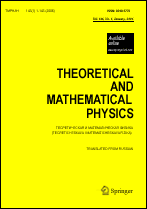|
Increase in entropy and time irreversibility in Hamiltonian dynamics
V. P. Pavlova, V. M. Sergeevb, R. V. Shaminc
a Steklov Mathematical Institute of Russian Academy of Sciences, Moscow, Russia
b Center for Global Issues, MGIMO
c MIREA — Russian Technological University, Moscow, Russia
Abstract:
We construct a Hamiltonian field theory model that combines hydrodynamics and thermodynamics. In this model, the continuity equation and the Euler equation for a potential flow are used as the Hamilton equations; and equations of state (or the Gibbs equations, which are equivalent to them), as equations of second-class constraints. The Hamiltonian function density reduced to the surface of second-class constraints is the sum of densities of the kinetic and potential energies; free energy then plays the role of potential energy. The surface of second-class constraints is endowed with a natural symplectic structure. Canonical variables are also defined on the second-class constraint surface such that all physical variables can be expressed as functions of these variables. In particular, from the standpoint of the Hamiltonian formalism, entropy is interpreted as a generalized velocity – a Lagrange multiplier for the corresponding second-class constraint expressing the temperature as a function of the canonical variables at the last reduction stage. This multiplier is expressed in terms of the canonical variables at the last stage, yielding a nontrivial equation of motion for entropy. The model must be made more concrete by fixing the dependence of the specific free energy on its arguments. We choose the simplest nontrivial variant, the monatomic van der Waals gas whose atoms are in the ground state. The canonical Hamilton equations allow calculating the rate of change in the entropy of this dynamic system. For the physically interesting case where the system evolution leads to equilibrium, the entropy and its rate of change are functionals of the solution of dynamic equations for the density. A numerical solution of these equations gives a monotonic growth of the entropy (for a finite evolution time). The equation can be linearized to find the time asymptotics; an elliptic equation with the “wrong” sign of the analogue of the squared speed of sound, rather than a hyperbolic equation, is obtained for the asymptotic evolution of the density deviation from the equilibrium value. Thus, the time reversibility of the solution is lost.
Keywords:
Hamiltonian dynamics, closed Hamiltonian system, entropy growth, time irreversibility.
Received: 08.12.2020
Revised: 17.12.2020
Citation:
V. P. Pavlov, V. M. Sergeev, R. V. Shamin, “Increase in entropy and time irreversibility in Hamiltonian dynamics”, TMF, 208:1 (2021), 85–96; Theoret. and Math. Phys., 208:1 (2021), 926–936
Linking options:
https://www.mathnet.ru/eng/tmf10024https://doi.org/10.4213/tmf10024 https://www.mathnet.ru/eng/tmf/v208/i1/p85
|


| Statistics & downloads: |
| Abstract page: | 314 | | Full-text PDF : | 94 | | References: | 51 | | First page: | 20 |
|




 Contact us:
Contact us: Terms of Use
Terms of Use
 Registration to the website
Registration to the website Logotypes
Logotypes








 Citation in format
Citation in format 